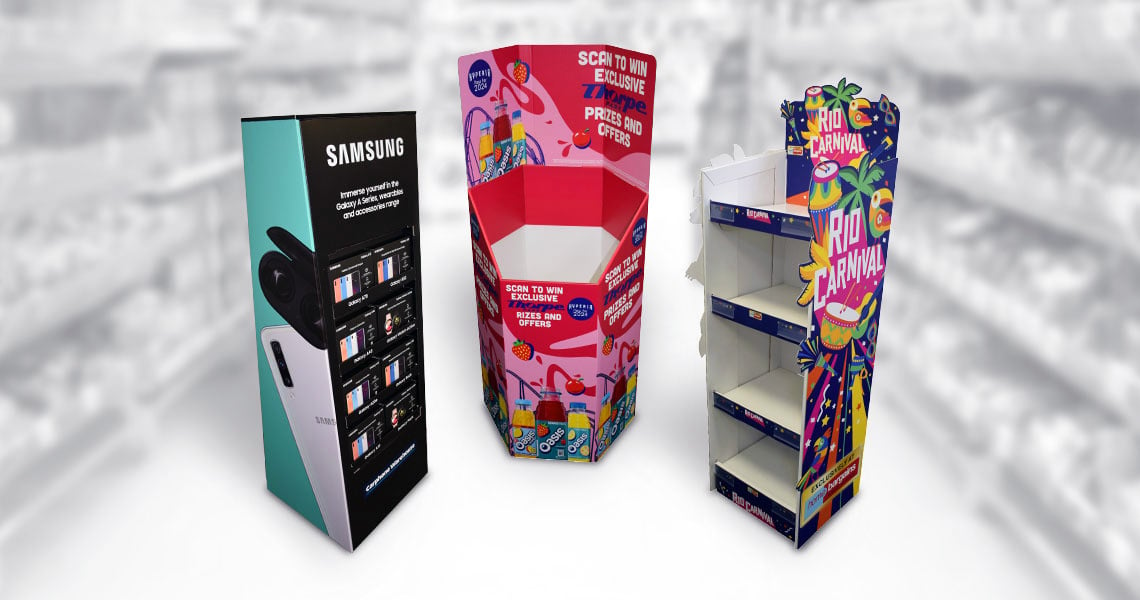Have you ever wondered why the design of a shelved cardboard stand seems to vary so much? They all do the same job and have the same number of shelves so why is one design more expensive than another? Why can’t I get all my displays to deliver flat or hold the same amount of weight?
Shelved displays are an excellent way to showcase products in retail spaces. They enhance brand visibility, encourage impulse purchases, and support short-term promotions or product launches. Typically made from sustainable materials like cardboard, they offer a cost-effective and environmentally friendly marketing solution. However, their design plays a crucial role in their cost, durability, and ease of use. Understanding these factors can help in-store marketers and point-of-sale managers make informed choices.
Assembly Considerations
One of the first design choices to consider is how the display will be assembled. Fully assembled displays, delivered in large boxes, ensure store compliance and consistency but come with higher costs due to increased shipping volume. Flat-pack displays, on the other hand, are more cost-effective to transport but require in-store assembly, which can impact execution and compliance.
The Role of Cardboard Engineering
The strength and cost of a Free Standing Display Unit (FSDU) largely depend on the engineering of the cardboard structure. Factors such as the number of sheets used, the type of folds, and the amount of gluing required directly affect manufacturing costs. A well-optimised design balances strength with material efficiency, ensuring a sturdy display without unnecessary expense.
Types of Cardboard FSDUs
There are several common types of FSDUs, each suited for different retail needs:
-
Standard Shelved FSDUs – Traditional units with multiple shelves, ideal for lightweight products.
-
Stackable FSDUs – Modular units that can be adjusted in height depending on stock levels.
-
Dump Bin FSDUs – Open-top designs perfect for loose or promotional products.
-
Hooked FSDUs – Equipped with peg hooks to display hanging merchandise like accessories.
-
Interactive FSDUs – Incorporating digital screens, QR codes, or motion elements for engagement.
-
Pallet Displays – Larger, sturdier units designed for placement on retail pallets for bulk sales.
Each type has its advantages depending on product weight, retail space, and budget constraints. Choosing the right design can significantly impact both cost and performance.
Optimising Strength and Cost
The way shelves are integrated into an FSDU has a significant effect on both strength and material efficiency. Some designs require additional reinforcement, which increases costs, while others leverage the sidewalls for added structural integrity. By strategically designing the connection points and load distribution, it’s possible to achieve both durability and cost savings.
For example, connecting shelves directly to the side panels can create a sturdier structure without excessive layering of materials. Reinforced edges and smart folding techniques can further enhance strength while keeping costs in check. The key is to engineer a solution that meets display requirements without unnecessary complexity.
Making the Right Design Choices
Every retail space comes with unique challenges—from limited floor space to strict handling requirements. Some displays must support stock weight in transit, while others need to be compact for easy transport. Adapting designs to these challenges is what sets effective point-of-sale solutions apart.
At the heart of great display design is a strategic blend of materials, print expertise, and logistics. By asking the right questions and leveraging expert manufacturing knowledge, brands can create high-impact, cost-effective displays that drive sales.
🚀 Launching a new product or promotion? Our award-winning CAD engineers design smart, tailored solutions to elevate your products and meet your unique needs. Get in touch today!
